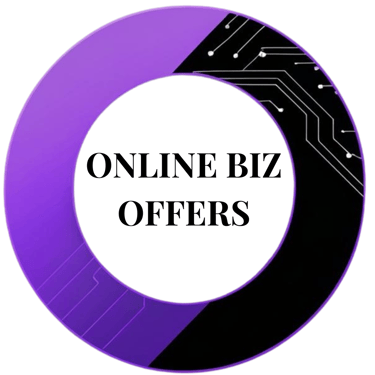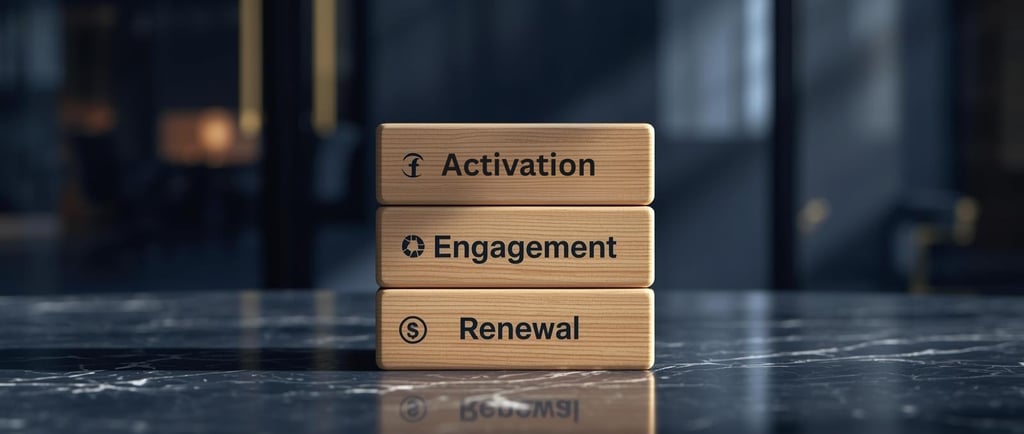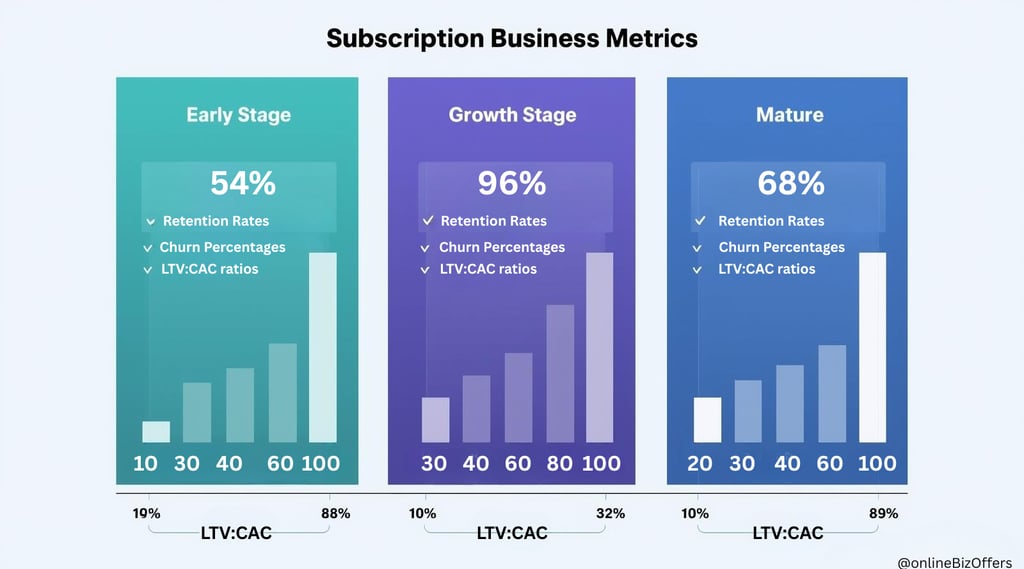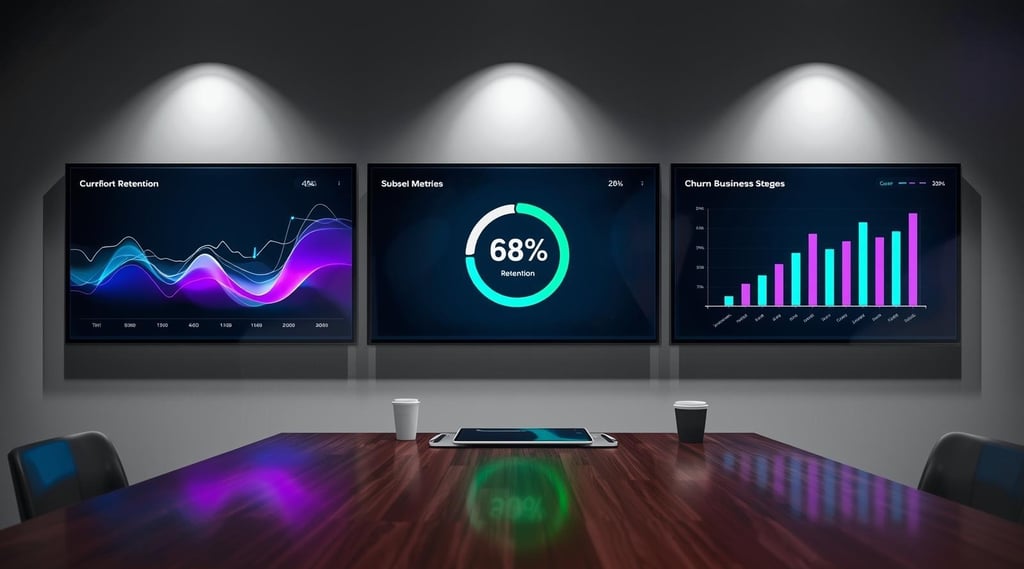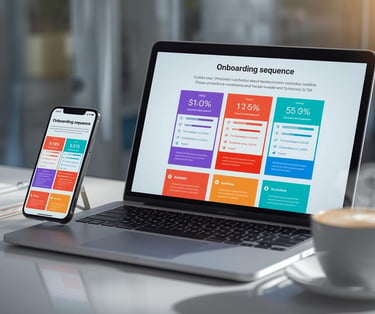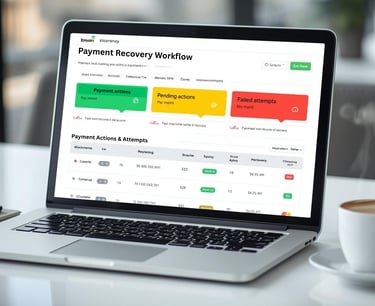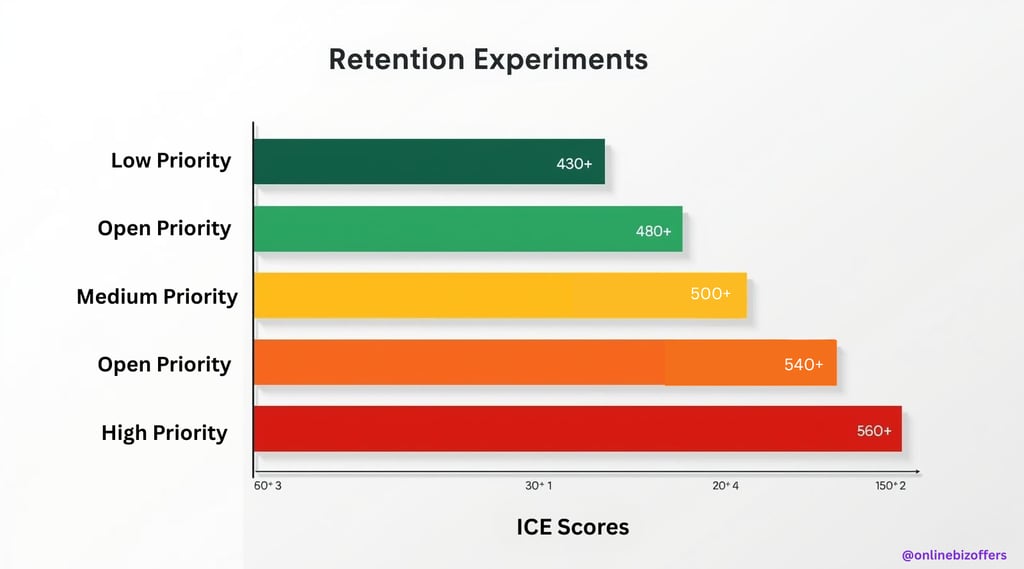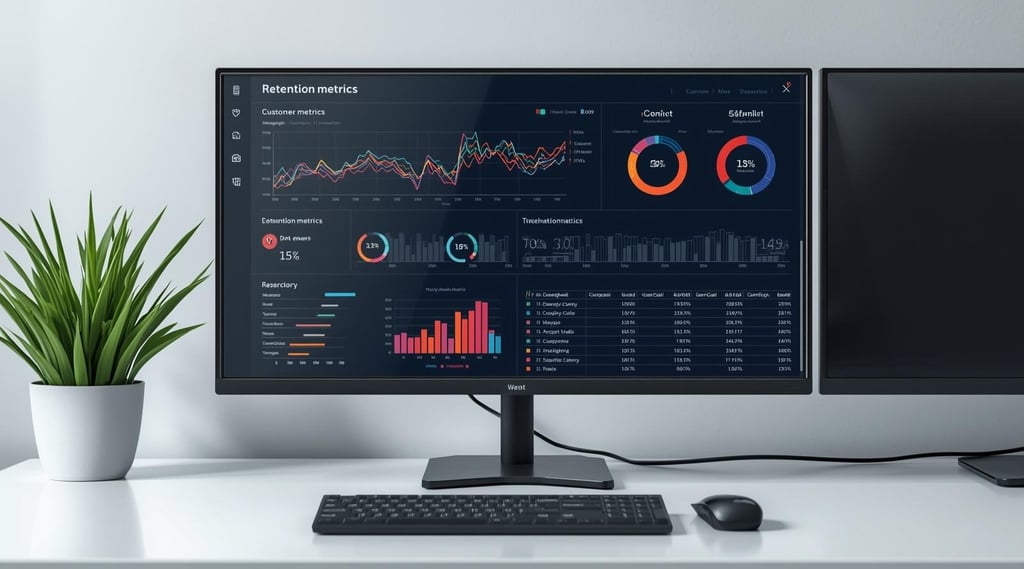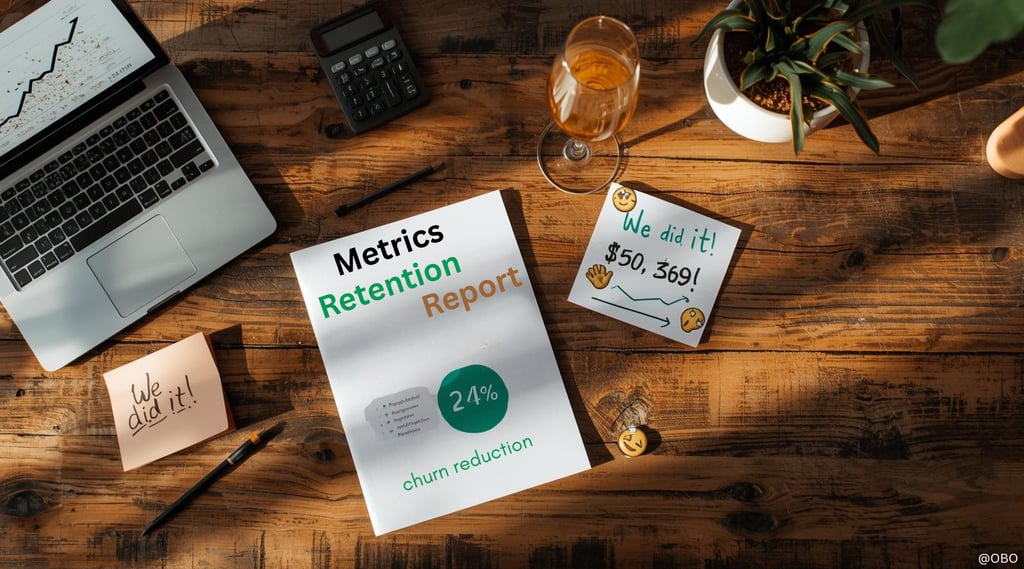Stop Scrolling, Start Creating ⚡ Visit Our Digital Store Now!
The Retention Playbook: Keeping Customers in Subscription Models
Master the retention playbook for keeping customers in subscription models. Discover proven strategies, metrics, and tactics to reduce churn, boost LTV, and build sustainable recurring revenue for your business.
DIGITAL MARKETINGE-COMMERCEAFFILIATE MARKETINGONLINE BUSINESS IDEASFREELANCINGEMAIL MARKETINGSOCIAL MEDIA
Eddy Enoma
10/23/202533 min read
Reduce Churn, Boost LTV, and Build Recurring Revenue That Lasts
Introduction: Why Customer Retention Makes or Breaks Subscription Businesses
Here's something most founders learn the hard way: acquiring a new customer costs five to seven times more than keeping an existing one. Yet, many subscription businesses obsess over growth while watching their customer base leak like a broken bucket. The retention playbook for keeping customers in subscription models isn't just about preventing cancellations. It's about building a business that compounds value over time, where each cohort of customers becomes more valuable than the last.
The math is brutal but simple. If you're losing 10% of your customers every month, you need to acquire at least that many just to maintain your current level. But here's the flip side: reduce that churn by even 5%, and you've essentially given yourself a 50% boost in customer lifetime value. That's not just revenue growth, it's margin expansion, because you're not spending acquisition dollars to replace lost customers.
This guide walks you through everything you need to know about retaining customers in subscription models, from the key metrics to the tactical playbooks that drive results. Whether you're running a SaaS platform, a DTC subscription box, or a membership community, these strategies work. Let's get started.
The Three Retention Levers That Actually Matter
Before you drown in tactics, understand this: there are only three fundamental ways to improve retention in any subscription business. Master these, and everything else becomes execution.
Lever 1: Get customers to value faster (Activation)
Your first 30 days determine everything. Research shows that customers who reach a meaningful milestone within their first week are 3x more likely to stick around past month three. This isn't about feature tours or welcome emails. It's about orchestrating an experience that delivers tangible value before the novelty wears off.
The impact here is massive. Improving activation rates by 10-15 percentage points typically reduces early churn by 25-40%. The effort? Medium. You'll need product, marketing, and customer success aligned, but the changes are mostly workflow and communication-based, not deep technical rebuilds.
Lever 2: Build habit loops into your product (Engagement)
The difference between a tool and a habit is frequency. Tools get evaluated on ROI every renewal cycle. Habits just happen. Your job is to create natural triggers that bring users back to your product multiple times per week, then reward those visits with genuine value delivery.
Companies that achieve daily or near-daily usage see churn rates 60-70% lower than those with weekly usage patterns. The effort here is higher because it often requires product changes, but the ROI is permanent. Once habits form, they're sticky.
Lever 3: Optimize the moment of truth (Renewal Experience)
Every subscription has a moment where the customer consciously or unconsciously decides whether to continue. For monthly plans, it's often triggered by the payment notification. For annual plans, it's the renewal email 30 days out. These moments are make-or-break, and most companies completely blow them with generic transactional messages.
Simple optimizations here (better dunning, proactive outreach to at-risk accounts, contextual win-back offers) can reduce voluntary churn by 15-25% with relatively low effort. Start here if you need quick wins.
Understanding how to calculate your real customer acquisition cost makes these retention levers even more critical. When you know your true CAC, you can model exactly how much additional profit each percentage point of retention improvement delivers.
Baseline Metrics: Know Your Numbers Before You Optimize
You can't improve what you don't measure. Here's your essential metrics framework for any subscription business, with realistic benchmarks across three stages of maturity.
Core Retention Metrics You Should Track
Gross MRR Churn measures the revenue you lose from cancellations divided by your total monthly recurring revenue. Early-stage businesses typically see 5-10% monthly growth, stage companies tighten this to 3-5%, and mature businesses operate at 1.5-3% monthly churn.
Net MRR Churn is more sophisticated. It takes your lost revenue, subtracts any expansion revenue from upgrades, and then divides by total MRR. Early-stage businesses run 3-7% monthly, growth stage aims for 0-3%, and mature subscription companies achieve negative net churn, meaning expansions exceed cancellations.
Logo Churn Rate simply counts how many customers you lose divided by the total customers. Target 3-7% monthly for early stage, 2-4% for growth stage, and 1-2.5% for mature businesses.
90-Day Retention tells you what percentage of each signup cohort is still active after three months. Aim for 45-65% in the early stage, 60-75% in the growth stage, and 70-85% once mature.
Annual Retention is your 12-month cohort survival rate. Early stage should target 30-50%, growth stage 50-70%, and mature businesses 65-80%.
Activation Rate measures the percentage of new users who hit your core value milestone in the first week. This climbs from 20-35% early stage, to 35-50% growth stage, to 50-70% at maturity.
CAC Payback Period shows how many months it takes to recover your customer acquisition cost. Early-stage businesses often need 12-24 months, growth stage tightens to 6-12 months, and mature companies operate at 3-8 months.
LTV:CAC Ratio compares lifetime value to acquisition cost. Target 1.5:1 to 3:1 early, scale to 3:1 to 5:1 in growth, and reach 5:1 to 8:1 at maturity.
The metric that matters most? Net MRR churn. This tells you whether your existing customer base is growing or shrinking in value. Mature subscription businesses achieve negative net churn, meaning expansions and upgrades exceed cancellations. That's the holy grail, where growth compounds on itself.
Data and Instrumentation: Track the Right Events
You need clean data before you can run effective retention experiments. Most teams either track too little (flying blind) or too much (drowning in noise). Here's the essential event schema that powers retention analytics.
Critical Events to Instrument
User Journey Events include sign-up completed (capture channel, referrer, campaign), onboarding started and completed, activation milestone reached (define this based on your aha moment), session start and end (track frequency and duration), and key feature usage for your 3-5 core features that correlate with retention.
Monetization Events cover subscription started (plan ID, billing cycle, price point), payment succeeded and payment failed, plan upgraded and downgraded, subscription paused if you offer this option, and subscription canceled (capture reason and whether it's immediate or end of term).
Engagement Signals track email opened, email clicked, push notification clicked, support ticket created and resolved, feedback submitted through NPS surveys or in-app ratings, and referral sent and converted.
Sample Event Properties Schema
Every event in your analytics system should capture these essential details. Think of this as the DNA of each customer action. When someone starts a subscription, you want to know not just that they subscribed, but what plan they chose, how much they're paying, where they came from, and any promotional codes they used. This data becomes crucial later when you're trying to understand which acquisition channels bring the best long-term customers or which promotions actually lead to sticky users versus bargain hunters who churn quickly.
Understanding Your Retention Data
The technical backbone of retention optimization is tracking the right data points. You're essentially asking three questions: How many customers from each signup month are still with me? Which acquisition channels bring customers who stick around? At what point are customers most likely to cancel?
Most modern analytics platforms like Rewardful handle these calculations automatically through visual dashboards. You don't need technical expertise yourself. Instead, connect your payment processor and customer database to these tools, and they'll generate retention cohort reports, activation funnels, and churn analysis with a few clicks.
If you do have a technical team member, share the concepts with them. Tell them you need to track monthly cohort retention (what percentage of each signup month's customers are still active), activation rates by marketing channel (which traffic sources bring the best long-term customers), and early warning signals for churn (when usage drops significantly). They'll know how to build these reports in whatever analytics stack you're using.
Cohort Analysis: Segment Smarter, Retain Better
Not all customers are created equal, and treating them as a homogenous blob is retention suicide. Smart segmentation lets you personalize experiences, prioritize resources, and run targeted experiments that actually move the needle.
How to Build Actionable Cohorts
Time-Based Cohorts group customers by their signup month or quarter. This lets you compare how different acquisition periods perform and spot seasonal patterns or the impact of product changes over time.
Channel Cohorts segment by acquisition source, like organic search, paid social, partnerships, or referrals. Some channels bring customers with wildly different retention profiles. Your paid search customers might churn faster, but have a higher initial average revenue per account. Your referral customers might stick around longer, but need a different onboarding.
Behavioral Cohorts group by usage patterns in the first 7–30 days. High-frequency users, feature explorers, and minimal users all need different retention strategies. This is where you find your power users worth nurturing and your at-risk users who need intervention.
Value Cohorts segment by revenue tier, such as under $50 monthly, $50-200, $200-500, and $500 plus. Your whales and minnows have completely different needs, risk profiles, and expansion opportunities.
Priority Segments for Retention Experiments
Focus your efforts on these four segments for maximum ROI:
Recent Upgrades and Expansions (Last 30 days) represent customers who just voted with their wallets that they see value. They're primed for deeper engagement, referral asks, and case study participation. Churn risk is low, and expansion potential is high. Nurture them aggressively.
At-Risk Accounts (Declining usage for 2+ weeks) show engagement drop as the leading indicator of churn. When weekly active users decline 40% or more from their baseline, you've got 30–60 days to intervene. Trigger automated check-ins, offer help resources, or assign a human touch if they're high-value.
High LTV Customers (Top 20% by revenue) often generate 60-80% of your revenue. They deserve white glove treatment. Proactive outreach, dedicated success managers, and early access to new features. Losing one whale hurts more than losing ten minnows.
Long-Tenured Customers (12+ months active) are your loyalists. They've survived the retention curve danger zones. They're less likely to churn organically but vulnerable to competitive poaching. Keep them engaged with exclusive perks, community access, and loyalty rewards.
Example Cohort Retention Performance
Imagine tracking cohorts from January through June 2024. Your January cohort started at 100% on signup, dropped to 68% after month one, 54% by month three, 45% at six months, and 38% at twelve months. Each subsequent month shows improvement as you optimize your retention playbook. Your June cohort hits 76% retention at month one and 65% at month three, dramatically better than January's performance.
Notice how later cohorts show improving retention? That's what good retention work looks like. Each iteration of your onboarding, product, and engagement strategy should compound into better cohort performance.
Onboarding and Activation: The Make-or-Break First 30 Days
Your onboarding sequence is your highest leverage retention opportunity. Period. The customers who find value in week one stick around. The ones who don't are already mentally checked out, just waiting for the billing cycle to end.
The Activation Milestone Framework
First, define your activation milestone. This isn't "completed profile" or "watched tutorial video." It's the specific action or outcome that correlates with long-term retention. For different business types, consider these examples:
A project management tool might define activation as creating the first project and inviting 2 or more team members. An analytics platform could use a connected data source and viewed first dashboard. A content creation tool might track the published or exported first piece of content. A community platform needs members to make their first post and receive engagement from others.
Run the analysis: what percentage of users who complete this action within 7 days are still active at 90 days? If it's significantly higher than users who don't, you've found your activation milestone.
Day-by-Day Onboarding Sequence
Day 0 (Immediate Post-Signup) sends a welcome email within 60 seconds, setting expectations and offering a quick win. Show an in-app checklist displaying the path to your activation milestone. Add contextual tooltips on core features, not every feature, just the critical path to value.
Day 1 includes a check-in email if the activation milestone hasn't been reached yet. Use subject lines like "Quick question about [Product]" with body copy that provides a simple value reminder plus a direct link to the activation action.
Day 3 delivers a progress email showing what they've accomplished. Include a social proof element like "thousands of teams like yours use this to accomplish [outcome]." Address common early friction points with educational content.
Day 7 marks your activation checkpoint. If they are activated, reinforce the win and introduce next-level features. If they haven't activated, make a direct offer of help through reply email, booking a call, or watching a 3-minute video.
Day 14 provides an engagement nudge based on behavior. For active users, spotlight features that build on what they're already doing. For inactive users, send a last attempt value reminder with a time-limited incentive if appropriate.
Day 21 establishes rhythm by sharing best practices, customer stories, or use case libraries. Include a soft ask for feedback or product input to build engagement.
Day 30 begins the first renewal preparation for monthly subscribers. Highlight value delivered, preview what's coming, and address objections preemptively before they become cancellation reasons.
Sample Email Templates
Welcome Email (Day 0):
Subject: Welcome to [Product] - let's get you set up
Hi [First Name],
Thanks for joining [Product]. You're about to [primary benefit, specific and tangible].
Here's what happens next:
[First action] takes 2 minutes
[Activation milestone] is where the magic happens
[Ongoing value] is when it becomes a habit
[CTA Button: Get Started]
I'm here if you need anything. Just reply to this email.
[Your Name] [Role], [Company]
Day 7 Activation Checkpoint (Not Yet Activated):
Subject: Stuck? I can help
Hi [First Name],
I noticed you haven't [activation milestone] yet. That's usually the moment when [Product] clicks for people.
Is something blocking you? Common hiccups we see:
Point one: [Common issue 1] with quick fix being [solution]. Point two: [Common issue 2] solved by [solution]. Point three: [Common issue 3] resolved through [solution]
Want me to walk you through it? [Book 15-min call] or just reply to this email.
[Your Name]
Tools like Tidio can power intelligent chat sequences that guide users through onboarding in real-time, answering questions before they become blockers. For email automation, GetResponse handles sophisticated drip sequences without requiring technical expertise.
Engagement and Product Usage: Building Habits That Stick
Activation gets people in the door. Engagement keeps them coming back. The companies that win on retention build products that become part of their customers' daily workflows, not tools they remember to check occasionally.
Top 10 Product-Based Retention Tactics
1. Default to Notifications (But Make Them Valuable)
Every notification is a trigger to return. But useless notifications train users to ignore you. Send notifications only when there's genuine new value, a decision needed, or relevant activity from their network.
2. Progress Indicators and Streaks
Humans are wired to complete things. Show progress toward goals, celebrate milestones, and create streaks that people don't want to break. Duolingo's streak system is genius because losing a 47-day streak feels painful.
3. Social Proof and Network Effects
Show activity from team members, peers, or the broader community. Messages like "5 teammates have used this feature this week" create FOMO and discovery. Collaboration features often have 40-50% higher retention than solo tools.
4. Personalized Feature Discovery
Don't shove your entire product at users day one. Introduce advanced features contextually, when they're relevant to what the user is already doing. Suggest "Based on your use of feature A, you might find feature B helpful."
5. Empty State Optimization
New users see empty states before they see value. Make those screens instructive, not just blank. Show examples, offer templates, or provide sample data to interact with.
6. Time-Based Re-engagement
When usage drops, trigger interventions. Send messages like "We noticed you haven't logged in for a week. Here's what's new" or "Your team completed 47 tasks while you were away."
7. Value Reporting
Monthly or quarterly emails showing the value they've received give concrete proof of ROI. Share metrics like "You've saved 23 hours this month using [Product]" or "Your content reached 15,000 people."
8. Gamification Elements
Points, badges, and leaderboards work when tied to real value delivery. Don't gamify for the sake of it, but when it reinforces behaviors that correlate with retention, lean in.
9. Adaptive AI Assistance
Use AI to surface insights, recommendations, or automations based on user behavior. Tools like Emergent offer ways to embed intelligent assistance directly into products.
10. Community and Peer Learning
Users who engage with your community through forums, Slack channels, or events churn at dramatically lower rates. They've built relationships and identity around your product, which creates switching costs.
Segmented Messaging Templates
For New Users (Days 0-30), keep in-app messages helpful, educational, and encouraging. Use push notifications rarely, only for critical milestones or time-sensitive actions. Send emails 2-3 times per week, focused on activation and early wins.
For Declining Usage (40% or more drop from baseline), use in-app messages like "We've missed you. What can we help with?" Send personalized push notifications based on their past behavior. Email with direct, empathetic check-ins from a real person.
For Power Users (Top 20% by activity), offer in-app messages about early access to beta features and exclusive tips. Use push notifications for advanced use cases and power features. Send emails featuring community spotlights and influence opportunities.
Example Behavioral Email Copy
Scenario 1: New User, Low Engagement (Day 10)
Subject: Is [Product] working for you?
Hi [First Name],
I'm checking in because I see you signed up for [Product] but haven't [activation action] yet.
That's usually the turning point where people tell us "Oh, NOW I get it."
Is something not clicking? Common things that trip people up:
First misconception: [Wrong belief], when actually [correct understanding]. Second misconception: [Wrong belief], solved by [quick tip]. Third misconception: [Wrong belief], try this [link to resource]
I've got 15 minutes tomorrow at [time] or [time] if you want to hop on a quick call. Otherwise, hit reply and let me know what's blocking you.
[Your Name]
Scenario 2: Declining Usage, Previously Active
Subject: Did we lose you?
[First Name],
You were crushing it with [Product] a few weeks ago (loved seeing [specific accomplishment]), but I noticed activity dropped off.
Everything okay? Did something change?
Common reasons people pull back:
Got busy with [their likely pain point]. Needed a feature we don't have yet. Found it overwhelming as the team grew
Which sounds closest? Reply and tell me what's up. If there's something we can fix or make easier, I want to know.
[Your Name]
Scenario 3: Power User Upsell
Subject: You're maxing out [Plan Name]
Hi [First Name],
Your team is absolutely crushing it with [Product]. You've [impressive stat], which puts you in the top 5% of [Plan Name] users.
Which also means you're probably hitting some limits. Here's what you're missing:
[Limit 1] solved by [Pro Plan benefit] [Limit 2] addressed through [Pro Plan benefit] [Limit 3] eliminated with [Pro Plan benefit]
Most teams at your usage level see [specific ROI metric] when they upgrade to [Pro Plan].
Want to see exactly what you'd get? [Link to personalized upgrade page]
Or if you want me to walk through it, grab time here: [Calendar link]
[Your Name]
For testing email variations and optimizing conversion, A/B Testing AI can help you run statistically significant experiments faster. Manychat powers automated messaging sequences across multiple channels without coding.
Billing, Pricing, and Payment Optimization
Involuntary churn from failed payments kills many subscriptions before customers even realize they've churned. Smart dunning processes can recover 20-40% of failed payments, adding pure margin to your business.
Involuntary Churn: The Silent Killer
Here's what most founders don't realize: 20-40% of all churn is involuntary. Expired cards, insufficient funds, and billing address mismatches happen constantly. The customer wanted to stay, but the payment failed, and you lost them anyway.
The fix is systematic dunning. Here's your recovery playbook:
Attempt 1 (Immediate) triggers an automatic retry within 1 hour. Show an in-app banner saying "Payment issue - update card." Send a friendly email heads-up explaining that the issue requires a simple fix.
Attempt 2 (Day 3) includes a second automatic retry. Escalate the email tone to "Action needed on your account." Send an SMS if you have permission with a direct update link.
Attempt 3 (Day 7) makes a final automatic retry. Use an urgent email tone explaining specific consequences if not resolved. Offer alternative payment methods like PayPal, wire transfer, or check for B2B customers.
Day 10 (Before Cancel) requires manual outreach for high-value accounts. Make phone calls if annual recurring revenue exceeds $5,000. Offer payment plans if there are indications of financial hardship.
Post-Cancel (Day 30, 60, 90) treats them as churned customers in your winback sequence. Use different offers and messaging based on the cancellation reason.
Sample Dunning Email Copy
First Failed Payment:
Subject: Quick fix needed for your [Product] account
Hi [First Name],
We tried to process your payment for [Product] today, but it didn't go through. This happens all the time (expired cards are the usual culprit), and it's a quick fix.
[Update Payment Method Button]
Your account is still active for now, but you'll lose access if we can't process payment by [date]. Update your payment info and you're all set.
Questions? Just reply.
[Your Name] [Company]
Third Failed Payment:
Subject: Last chance - [Product] account will be paused tomorrow
[First Name],
We've tried processing your payment 3 times now, and we're still having issues. Your [Product] account will be paused tomorrow if we can't resolve this.
That means you'll lose access to [critical feature], your data will be archived (recoverable for 90 days), and your team members will lose access.
[Update Payment Method Now]
If there's a billing issue we can help with, like payment plans or different payment methods, reply and let me know.
[Your Name] [Company]
Voluntary Churn: Retention Offers That Work
When customers initiate cancellation, you get one chance to save them. Make it count with smart, personalized retention offers.
Decision Rules for Retention Offers:
High LTV customers in your top 30% deserve aggressive discounts of 25-50% for 3 months or service upgrades. Medium LTV customers get moderate discounts of 15-25% for 2 months or pause options. Low LTV customers receive no discount, just an offer to downgrade or pause only. Recent signups under 60 days need activation support focus, not discounts. Long-tenured customers with 12+ months get loyalty appreciation and requests for specific feedback.
Retention Offer Scripts:
Pause Option:
"Before you cancel, would a pause work better? We can freeze your account for 30-90 days without charging you, and you can reactivate whenever you're ready. Your data and settings stay exactly as they are. [Pause My Account]"
Discount Retain:
"I'd hate to see you go. Let me make you an offer: Stay with us and I'll give you 30% off for the next 3 months. No strings attached. If it's not worth it after 3 months, cancel anytime. [Accept Offer - 30% Off]"
Downgrade Path:
"Sounds like [Pro Plan] might be more than you need right now. What if you moved to [Basic Plan]? You'd still get [core features], just without [premium features]. And it's only $[price] instead of $[current price]. [Switch to Basic Plan]"
Service Recovery:
"I see you're canceling because of [stated reason]. That's on us, and I want to make it right. Can I personally walk you through [solution]? It'll take 10 minutes max, and if it doesn't fix the issue, I won't bother you again. [Book 10 Min Call]"
When you're testing different pricing and packaging approaches, understanding your true unit economics matters. Check out our guide on calculating your real customer acquisition cost to model retention offers accurately.
Winback and Reactivation: Bringing Lost Customers Back
Churned customers are your warmest leads. They've already evaluated you, paid you money, and have experience with your product. Reactivation campaigns often convert at 10-30%, which is dramatically higher than cold acquisition.
Segmented Winback Sequences
Not all churned customers are equal. Segment by tenure and churn reason to personalize your approach:
Recent Churns (Cancelled within 30 days of signup) represent activation failures. Your winback message should address the core objection or friction point. Send messages on day 7, day 21, and day 60 post-churn. Use the angle "We've made it easier to [solve their core problem]." Offer extended trials or guided onboarding sessions.
Mid-Tenure Churns (3-9 months active, then churned) found value initially, but something changed. Focus on what's new or improved since they left. Reach out on day 14, day 45, day 90, and day 180 post-churn. Lead with "Here's what you've missed" and showcase new features or value. Offer discounts on the first month back or upgraded plan at the previous price.
Long-Tenure Churns (9+ months active) represent valuable relationships. Something significant drove them away, like a competitor,a budget cut, or a key stakeholder departure. Treat these as high-touch reacquisitions. Send immediate personal outreach, then follow up on day 30, day 90, and day 180. Use personal relationship-based angles like "I'd love to understand what happened." Create customized offers based on conversation, often including service additions or pricing flexibility.
Winback Email Templates
Day 7 Post-Churn (Recent Signup):
Subject: Can I ask you one question about [Product]?
Hi [First Name],
I saw you cancelled [Product] last week. Before you fully move on, can I ask: what didn't work?
I'm not trying to sell you. I genuinely want to understand where we fell short. Was it that we didn't solve [core problem] the way you expected? Too complicated to get value from? Missing a feature you needed? Something else entirely?
30 seconds to reply would help us get better.
[Your Name]
Day 45 Post-Churn (Mid-Tenure):
Subject: We've made some changes you should know about
[First Name],
Since you left [Product], we've shipped some updates that directly address feedback from users like you:
Feature one now delivers [specific benefit]. Feature two provides [specific benefit]. Feature three enables [specific benefit]
I'm not sure if [reason they churned] was your issue, but if so, we've solved it.
Want to take another look? I'll give you [offer: 50% off for 2 months, extended trial, or free upgrade].
[Reactivate My Account]
[Your Name]
Day 90 Post-Churn (Long-Tenure):
Subject: I miss working with you
Hi [First Name],
It's been 3 months since your team moved on from [Product], and I realized I never properly reached out to understand what happened.
You were with us for [tenure], which means we were solving real problems for you. Then something changed.
Would you be open to a quick call? Not to sell you anything. Just to understand what drove the decision and whether there's anything we could have done differently.
[Book 15 Minutes]
Either way, thanks for the time we had together. You helped make [Product] better.
[Your Name]
Winback Offer Strategy and Economics
The math on winback offers is straightforward: you can afford to be generous because the marginal cost of reactivation is near zero. Your product already exists, support infrastructure is in place, and these customers require minimal onboarding.
Target winback conversion rates break down as follows: Recent churns under 60 days should convert at 15-25%. Mid-tenure churns between 60-180 days convert at 10-20%. Long-tenure churns over 180 days convert at 5-15%.
Offer guidelines by segment suggest that high LTV accounts deserve up to 6 months at a 50% discount or free premium features. Medium LTV accounts get 2-3 months at a 30-40% discount. Low LTV accounts receive a 1-month discount or no financial incentive, just product improvements emphasized.
The key is testing different offers and measuring not just the initial reactivation rate, but also subsequent retention. A customer who comes back for a deep discount and churns again in 60 days isn't a win. You want reactivations who stay.
For managing complex winback campaigns across email and SMS, GetResponse provides affordable automation tools. EmailOctopus offers simple email marketing specifically designed for small subscription businesses.
Testing and Experimentation Framework
Retention improvement is a game of compounding 2-5% wins. You need a systematic approach to testing, measuring, and rolling out changes. Here's your experimentation playbook.
Prioritization Framework: Focus on What Moves the Needle
Not all retention experiments are created equal. Use the ICE scoring method to prioritize your backlog. Rate each potential experiment on impact (1-10), Confidence that it will work (1-10), and ease of implementation (1-10), then multiply the three scores together.
High Priority Initiatives (ICE Score over 400):
Adding an activation checklist to your onboarding typically scores around 500 with Impact 8, Confidence 7, and Ease 9. It's visual, guides users to value, and requires minimal engineering.
Improving your dunning email copy often scores 560 with Impact 7, Confidence 8, and Ease 10. You're literally just rewriting emails, but the impact on payment recovery is substantial.
Medium Priority Initiatives (ICE Score 150-400):
Personalizing onboarding flows by user segment scores around 210 with Impact 7, Confidence 6, and Ease 5. Higher impact but requires more technical work.
Lower Priority Initiatives (ICE Score under 150):
Building a full referral program scores around 90 with Impact 6, Confidence 5, and Ease 3. High effort, uncertain returns, only tackle this when fundamentals are solid.
12 High-Value Retention Experiment Ideas
1. Activation Checklist
Test the hypothesis that users who complete 3 or more checklist items in the first week will have 30% higher 90-day retention. Run an A/B test with a checklist versus no checklist for 500 users per variant. Measure D90 retention rate and aim for statistical significance.
2. Dunning Email Sequence
Test whether adding SMS to the dunning sequence recovers 15% more failed payments. Compare email only versus email plus SMS for all payment failures over 30 days. Track payment recovery rate within 7 days.
3. Usage-Based Email Triggers
Hypothesis: Triggered email when usage drops 50% increases reactivation by 20%. Test auto-trigger email versus control with no email for 1,000 users, showing usage decline. Measure the 14-day reactivation rate.
4. Retention Offer at Cancellation
Test if offering a 30% discount saves 25% of cancellation attempts. Compare the discount offer versus no offer for voluntary cancellations. Track cancellation completion rate and 60-day retention of saves.
5. Annual Plan Discount
Hypothesis: 15% discount on annual switches, 20% of monthly users within the first 60 days. Offer versus no offer to monthly subscribers at day 30. Measure conversion to annual and net revenue impact.
6. Onboarding Call for High-Value Signups
Test whether a proactive onboarding call increases activation by 40% for signups over $200 monthly. Compare outbound calls within 24 hours versus the standard email sequence. Track 7-day activation rate and 90-day retention.
7. Social Proof in Onboarding
Hypothesis: showing peer usage increases feature adoption by 25%. Test messages like "X teammates used this feature this week" versus standard UI. Measure feature adoption rate and engagement frequency.
8. Empty State Templates
Test if pre-populated templates increase activation by 35%. Compare the empty state with templates versus a blank canvas. Track first meaningful action completion and 7-day retention.
9. Value Reporting Email
Hypothesis: The monthly value summary increases renewal rate by 10%. Test monthly email highlighting usage stats versus no email. Measure the monthly retention rate month over month.
10. Pause Option
Test whether offering a pause instead of cancel reduces churn by 20%. Compare the pause option in the cancellation flow versus standard cancellation. Track churn completion rate and reactivation from pause.
11. Feature Discovery Modal
Hypothesis: contextual feature prompts increase adoption by 30% without hurting user experience. Test in-context modals versus no prompts for underutilized features. Measure feature adoption rate and session satisfaction score.
12. Community Access
Test if community members churn 40% less than non-members. Compare active community invitations versus passive community links. Track community join rate and 180-day retention comparison.
Understanding Sample Sizes for Testing
Here's the non-technical version: before running any retention experiment, you need enough users in both your test and control groups to trust the results. Too few users, and you might think something worked when it was just a random chance.
If your baseline retention is around 50% and you want to detect a 10% improvement, you need about 1,570 users in each group, meaning test and control. That's 3,140 total users going through your experiment.
If your baseline is 60% retention and you're looking for a 15% lift, you need 545 users per group, or 1,090 total.
If your baseline is 70% and you want to see a 20% improvement, you need 200 users per group, or 400 total.
The pattern is simple: higher baseline retention rates and bigger expected improvements need fewer test subjects. Lower baseline rates and smaller improvements require more users to prove the change actually works.
For most small businesses, this means you'll run experiments for 2-4 weeks to gather enough data. If you only get 100 signups per week, you'll need a month to test something properly. That's okay. Better to wait and get clean data than make decisions on incomplete information.
Running Clean Experiments
Common mistakes to avoid include testing during seasonal fluctuations like holidays or the end of the quarter, stopping tests early when you see positive results, testing multiple things simultaneously without proper randomization, ignoring novelty effects by not testing for at least 2 full billing cycles, and not accounting for user lifecycle stage in analysis.
Best practices require running tests for a minimum of 2-4 weeks to capture a full billing cycle, using consistent randomization so users don't switch groups, setting success metrics before launching, monitoring multiple metrics, including guard rails like engagement and support tickets, and documenting everything, including hypothesis, design, results, and learnings.
For tools to run and analyze these experiments, A/B Testing AI provides automated test design and statistical analysis.
Dashboards and Reporting: Measure What Matters
You can't manage retention by gut feel. You need dashboards that surface problems early and track progress over time. Here's your retention analytics stack.
What Your Retention Dashboard Should Show
You need three levels of reporting: daily pulse checks, weekly deep dives, and monthly strategic reviews.
Your Daily Dashboard (5-minute glance) checks new signups from yesterday, last 7 days, and last 30 days. Track how many customers churned in the same periods. Monitor payment failures and the dollar amount at risk. Look at your net new MRR (monthly recurring revenue). Get a quick snapshot of how your current month's cohort is performing at day 0, day 7, and day 14 compared to your targets.
Your Weekly Review (30-minute analysis) studies cohort retention curves for your last six months of signups. Break down your MRR churn into voluntary cancellations versus involuntary payment failures. Analyze activation rates by acquisition channel to see which marketing sources bring sticky customers. Review engagement metrics segmented by user type. Examine the top reasons customers give for canceling.
Your Monthly Business Review (90-minute strategic session) runs a full cohort analysis with lifetime value projections. Compare churn rates across different plan types and price points. Assess the distribution of customer health scores across your base. Evaluate winback campaign performance. Review results from retention experiments and plan your pipeline for next month.
Modern analytics platforms handle this automatically. Tools like Metricool or your existing analytics stack can generate these views without you writing a single line of code. The key is defining what you want to see, then having someone technical set up the dashboards once.
Tracking the Metrics Behind Your Dashboard
If you have a technical team member, they'll need to pull specific data points to power your retention dashboards. The concepts are straightforward, even if the implementation is technical.
For MRR Churn Tracking: Your team needs to calculate how much revenue you gained from new customers, how much you gained from existing customers upgrading, how much you lost from downgrades, and how much you lost from cancellations. Add up the gains and losses to get your net MRR movement each month. Calculate your churn rate by dividing lost revenue by your starting MRR.
For Payment Failure Tracking: Count how many payment attempts failed each day. Track how many recovered after the first retry, second retry, and third retry. Calculate what percentage ultimately churned because the payment never went through. This shows you how well your dunning process works and where money is leaking.
For Customer Health Scoring: Assign each active customer a score based on their usage patterns, engagement frequency, support ticket history, and payment reliability. Group customers into healthy, moderate risk, high risk, and critical categories. This tells you which accounts need proactive outreach before they churn.
The good news? If you're using modern subscription platforms like Stripe, Chargebee, or similar tools, they often provide these reports built in. You're connecting dots that already exist rather than building from scratch.
For visual dashboards that anyone on your team can understand, tools like Metricool help you build shareable reports without requiring technical knowledge.
90-Day Action Plan: Your Retention Roadmap
Strategy without execution is hallucination. Here's your concrete 30/60/90 day playbook to start moving retention metrics immediately.
Days 1-30: Foundation and Quick Wins
Week 1: Audit and Baseline
Calculate current metrics, including churn rate, activation rate, and LTV, with the analytics owner responsible. Set up basic event tracking if not in place with the engineering owner. Export the last 90 days of churn data with reasons through customer success or support. Interview 10 recently churned customers with the product or founder leading.
Week 2: Quick Wins
Improved dunning email copy and implemented a new sequence with the marketing owner. Add cancellation flow retention offer with the product owner. Fix the top 3 activation friction points from user interviews with the product owner. Set up a weekly retention review meeting with the growth lead owner.
Week 3: Onboarding Optimization
Map the current onboarding flow and identify gaps with the product owner. Create an activation milestone definition and measurement with the analytics owner. Draft a new onboarding email sequence with the marketing owner. Build an in-app activation checklist with the engineering owner.
Week 4: Engagement Foundation
Identify the top 5 features that correlate with retention with the analytics owner. Create usage-based email triggers for declining engagement with the marketing owner. Set up an NPS survey for the 30-day cohort with the customer success owner. Document the 3 highest priority experiments for the next 60 days with the growth lead owner.
Expected Impact: 5-10% reduction in early churn from day 0 to day 30.
Days 31-60: Testing and Optimization
Week 5: Launch First Experiments
A/B test the new onboarding sequence versus the control with the marketing owner. Test retention offer at cancellation with the product owner. Implement payment failure SMS notification with the engineering owner. Start weekly cohort analysis reviews with the analytics owner.
Week 6: Segmentation and Personalization
Build customer segments, including high-value, at-risk, and power users, with the analytics owner. Create segment-specific engagement campaigns with the marketing owner. Implement proactive outreach for at-risk accounts with the customer success owner. Set up referral tracking for organic growth with the engineering owner.
Week 7: Expansion and Upsell
Identify upgrade triggers and usage thresholds with the product owner. Create upgrade prompts for power users with the product owner. Build an annual plan conversion campaign with the marketing owner. Implement usage-based pricing if applicable, with the pricing committee owner.
Week 8: Winback Campaign
Segment churned users by tenure and reason with the analytics owner. Launch the first winback sequence with the marketing owner. Create special winback offers for high-LTV churns with the growth owner. Analyze experiment results from weeks 5-6 with the analytics owner.
Expected Impact: Additional 10-15% reduction in overall churn.
Days 61-90: Scale and Systematize
Week 9: Advanced Experimentation
Launch 3 new retention experiments from the backlog with the growth owner. Test community or peer-learning features with the product owner. Experiment with a loyalty rewards program with the marketing owner. Optimize the payment failure recovery process with the engineering owner.
Week 10: Customer Success Expansion
Implement customer health scoring with the customer success owner. Build a high-touch playbook for enterprise accounts with a customer success owner. Create a quarterly business review template for top accounts with the customer success owner. Train the team on retention metrics and goals with the growth lead owner.
Week 11: Product Refinement
Ship the top 3 feature requests from churn interviews with the product owner. Improve empty states and first-run experiences with the design owner. Add social proof and usage visibility with the product owner. Optimize in-app notifications and messaging with the product owner.
Week 12: Review and Plan
Comprehensive 90-day results review with the leadership owner. Update retention playbook based on learnings with the growth owner. Set new retention targets for next quarter with the leadership owner. Plan next quarter's experiment roadmap with the growth owner.
Expected Impact: 20-30% overall churn reduction from Day 1 baseline.
Resource Allocation by Team Size
Solo Founder or 2-Person Team: Focus exclusively on weeks 1-2 quick wins, then week 5 experimentation. Skip anything requiring dedicated engineering unless absolutely critical. Use no-code tools like Manychat for automated sequences and Tidio for chat support.
5-10 Person Team: Follow the full 90-day plan, but stretch the timeline to 120 days if needed. Assign clear, directly responsible individuals for each initiative. You can execute 60-70% of this concurrently.
10+ Person Team: Execute the full plan as written with dedicated resources. Add additional experiments and personalization layers. Consider building custom retention infrastructure versus relying on third-party tools.
Organizational Alignment: Getting Everyone Rowing Together
Retention isn't a department: it's a company-wide muscle. Here's how to align product, marketing, customer success, and analytics around retention goals.
The Retention Council Framework
Meeting Cadence includes daily standup done asynchronously for metric pulse check and escalations only. Weekly retention review takes 30 minutes for cohort performance, experiment updates, and quick decisions. Monthly business review runs 90 minutes for deep dives, strategic pivots, and quarterly planning. Quarterly retrospective dedicates half a day to reviewing what worked, what didn't, and big bets for next quarter.
Weekly Retention Review Agenda allocates 5 minutes for metrics snapshot covering current week churn, MRR, and activation versus targets. Spend 10 minutes on cohort a performance, and analyzing how recent cohorts trend versus historical. Use 10 minutes for experiment updates on what's live, early reads, and upcoming launches. Reserve 5 minutes for escalations and blocks needing immediate attention or cross-functional support.
Retention OKRs by Function
Product Objectives: Deliver activation and engagement that drives retention.
Key Result 1: Increase D7 activation rate from X% to Y%.
Key Result 2: Ship 3 features that improve D90 retention by 10% or more.
Key Result 3: Reduce time-to-value for new users from X to Y days.
Marketing Objectives: Optimize lifecycle communications for retention.
Key Result 1: Improve onboarding email open rates to 45% or higher and click rates to 12% or higher.
Key Result 2: Achieve a 20% or higher winback conversion rate
Key Result 3: Launch 5 retention experiments with statistically significant results
Customer Success Objectives: Proactively save at-risk accounts and expand healthy ones.
Key Result 1: Maintain customer health score above 75 for the top 30% of accounts.
Key Result 2: Reduce churn in accounts with CS engagement by 40%
Key Result 3: Drive 25% of MRR from expansions and upsells
Analytics Objectives: Provide actionable retention insights and infrastructure.
Key Result 1: Deliver a weekly retention dashboard with 99% or higher uptime.
Key Result 2: Run cohort analysis identifying 3 actionable improvement areas per quarter.
Key Result 3: Support 8 or more retention experiments with proper tracking and analysis
Sample Weekly Stakeholder Update
RETENTION SNAPSHOT - Week of [Date]
METRICS THIS WEEK:
New MRR: $X with Y% change versus last week
Churned MRR: $X with Y% change versus last week's
Net MRR Churn: X% compared to the target of Y%
D7 Activation: X% compared to target of Y%
Payment Recovery: X% compared to target of Y%
COHORT HEALTH:
October cohort tracking X% ahead of September at D14
September cohort retention at D30: X% with target of Y%
Trend: Positive, Negative, or Stable
EXPERIMENTS IN FLIGHT:
Experiment 1 early read shows a plus X% improvement on Day 12 of 28.
Experiment 2 shows launching this week to 500 users.
Experiment 3 results in, plus X% lift, rolling out to 100%
TOP WINS: Specific a win with numbers, and the Customer success story
ESCALATIONS: Issue requiring cross-functional attention, and Resource need or blocker
NEXT WEEK FOCUS:
Priority 1
Priority 2
Priority 3
For teams building custom retention workflows, Taskade AI helps coordinate cross-functional work with AI-powered project management.
Appendices: Templates and Scripts You Can Use Today
Full Email Template Library
Welcome Email (Day 0):
Subject: Welcome to [Product] - Your first step
Hi [First Name],
You just joined [number] teams using [Product] to [primary outcome]. Here's how to get the most out of your first week:
TODAY: [Activation action] This is where [Product] clicks for most people. [Direct link to start]
THIS WEEK: [Secondary valuable action] Once you've done [activation action], try [next step]. You'll see [specific benefit].
ANYTIME: Hit reply if you get stuck, and I read every response. If something's not working or you have questions, I'll help.
[CTA Button: Get Started]
[Your Name] [Role], [Company]
P.S. We have a [resource: guide, video, or template library] that helps new users get value faster. Check it out here: [link]
Day 3 Check-In:
Subject: How's [Product] working for you?
Hi [First Name],
Quick check-in. You signed up for [Product] a few days ago. How's it going so far?
I see you [action they've taken]. Nice work. The next step most people find valuable is [next action].
If anything's confusing or you're not sure where to start, just reply to this email. I'm here to help.
[CTA: Continue Setup]
[Your Name]
Day 7 Activation Milestone Celebration:
Subject: You did it!
[First Name],
You just [completed activation milestone]. That puts you ahead of most new users, and here's why that matters:
Teams that [complete milestone] in their first week are 3x more likely to still be using [Product] 3 months from now. You're setting yourself up for success.
What's next? Most power users move on to:
Advanced feature 1, Advanced feature 2, Integration or collaboration feature
Want a quick walkthrough of these? [Book 15 min call] or just reply and I'll send you resources.
Keep crushing it, [Your Name]
Customer Cancellation Interview Script
Opening:
"Hi [Name], thanks for taking the time. I saw you cancelled [Product] and wanted to understand what happened. This isn't a sales call, I'm genuinely trying to make [Product] better. Mind if I ask a few questions?"
Core Questions:
What originally led you to try [Product]?
What were you hoping it would help you accomplish?
Did you hit any early friction or confusion in the first few days?
What worked well?
What didn't?
What was the specific trigger that made you decide to cancel?
Did you evaluate alternatives?
What did you switch to? Is there anything we could have done differently that would have changed your decision?
On a scale of 1-10, how likely are you to recommend [Product] to others despite cancelling?
Why that score?
Closing:
"This is really helpful feedback. I appreciate your honesty. If we address [specific issue they mentioned], would you be open to trying [Product] again in the future? No pressure, just curious."
Post-Call Notes Template:
Churn reason category:
Price, Product Gap, Competitor, Timing, or Other
Key friction points: List
Feature requests: List
Winback potential: High, Medium, or Low
Action items: What to fix or test based on this feedback
Cancellation Survey Questions
Single-Select (Required):
"What's the primary reason you're cancelling?"
Too expensive for the value
Missing features I need
Too complicated to use
Switching to a competitor
No longer need this type of solution
Technical issues or bugs
Poor customer support experience
Other (please specify)
Multi-Select (Optional):
"What could we have done better?" Select all that apply:
Easier onboarding or setup
Better documentation or training
More responsive support
Different pricing options
Specific features: [text box] Better performance or reliability
More integrations
Open-Ended:
"Anything else you'd like us to know?"
Winback Offer (Conditional):
"Before you go, would any of these change your mind?"
30% off for 3 months
Pause account instead of cancel with no charge, reactivate anytime
Switch to a lower-priced plan
Free onboarding session with our team
No thanks, please proceed with cancellation
LTV Calculation Examples
Simple LTV (Average method):
LTV equals Average Monthly Revenue per Customer multiplied by Average Customer Lifespan in Months
Example: ARPA is $50 per month, average customer lifespan is 18 months, so LTV equals $50 times 18, which equals $900.
LTV with Gross Margin:
LTV equals ARPA multiplied by Gross Margin percentage, divided by Monthly Churn Rate
Example: ARPA is $50, gross margin is 80% monthly, churn is 5%, so LTV equals $50 times 0.80 divided by 0.05, which equals $800.
LTV with Expansion (More accurate):
LTV equals ARPA multiplied by Gross Margin percentage, multiplied by, result of 1 plus Monthly Expansion Rate divided by Monthly Churn Rate plus Monthly Discount Rate
Example: ARPA is $50, gross margin is 80%, monthly expansion rate is 2%, monthly churn is 5%, discount rate is 1% of cost for capital. LTV equals $50 times 0.80 times the result of 1.02 divided by 0.06, which equals $680.
CAC Payback Period:
Payback Period in months equals Total CAC divided by ARPA multiplied by Gross Margin percentage
Example: CAC is $600, ARPA is $50, gross margin is 80%, so Payback equals $600 divided by the result of $50 times 0.80, which equals 15 months.
LTV:CAC Ratio:
LTV:CAC equals LTV divided by CAC
Target ratios show, under 1:1 is unsustainable because you're losing money on every customer. 1:1 to 3:1 is acceptable for early stage, but needs improvement. 3:1 to 5:1 represents a healthy growth-stage business. 5:1 or higher indicates mature, efficient customer acquisition.
For modeling different scenarios and understanding how retention impacts these numbers, spreadsheet tools or Taskade AI can help you build dynamic financial models. Gamma creates professional presentations to share these projections with stakeholders.
Conclusion: Retention is Your Competitive Moat
Here's the reality: in subscription businesses, acquisition gets all the glory, but retention makes all the money. Every percentage point of churn you eliminate compounds over time into massive enterprise value.
The companies that win long-term aren't necessarily the ones that grow fastest. They're the ones who keep customers longest, expand them most effectively, and build products people can't imagine living without.
This playbook gives you the framework, but execution is everything. Start with the 90-day action plan. Pick three high-impact, low-effort initiatives from this guide and ship them this month. Measure obsessively. Iterate constantly. Celebrate small wins.
Remember: a 5% reduction in churn is worth more than a 5% increase in new customer acquisition, because you don't have to pay CAC to keep existing customers. Do the math for your business. The numbers will shock you.
Your retention playbook isn't something you build once and forget. It's a living system that evolves with your product, your customers, and your market. Review it quarterly. Update it based on what works. Share it with your team.
The subscription businesses that scale sustainably aren't just good at getting customers. They're exceptional at keeping them.
Now go reduce some churn.
Ready for the complete strategy to build sustainable growth? Check out our complete guide on How to Calculate Your Real Customer Acquisition Cost to understand the full economics of customer acquisition and retention working together. For insights on building network effects into your business model, explore Building Your First Marketplace: Supply vs. Demand.
Want these insights delivered? Subscribe to our newsletter.
Subscribe for Exclusive Tips & Updates. Enter Your Email Below!



Get the latest strategies to create, automate, and monetize with AI, content, and digital marketing straight to your inbox!
🔒 We respect your privacy. Your email is safe with us. Unsubscribe anytime.
Address
Sporerweg 16
94234 Viechtach, Germany
Contacts Us
(049) 170 499 6273
Subscribe to our newsletter
© 2025 Onlinebizoffers. All rights reserved.
